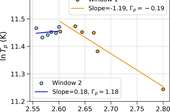 IIA SOUMYARANJAN KHUNTIA
IIA SOUMYARANJAN KHUNTIAThermal and turbulence characteristics of fast and slow coronal mass ejections at 1 AU
Understanding thermal and turbulence properties of interplanetary coronal mass ejections (ICMEs) is essential for analysing their evolution and interactions with the surrounding medium. This study explores these characteristics across different regions of two distinct ICMEs observed at 1 AU, utilizing in situ measurements from the Wind spacecraft. Polytropic indices (e for electrons and p for protons) reveal significant deviations from adiabatic expansion, suggesting sustained heating mechanisms within the ICMEs even at 1 AU. Effective polytropic index (eff) of the magnetic ejecta (ME) in both ICME1 and ICME2 is found to be near-isothermal (eff = 0.88 and 0.76), aligning with measurements near the Sun, highlighting consistent heating across heliospheric distances. Spectral analysis at the inertial scale reveals Kolmogorov-like turbulence in the fast ICME1’s ME, while ME of the slower ICME2 exhibits less-developed turbulence with a shallower spectral index (αB). Turbulence analysis in the dissipation scale indicates that the ME of slower ICME2 is less affected by the ambient medium than the faster ICME2. The MEs of both ICMEs show magnetic compressibility much smaller than unity (CB < 1), suggesting dominant Alfvénic fluctuations in the MEs. Notably, the partial variance of increments (PVI) method identifies more intermittent structures, such as current sheets and reconnection sites, in sheath and post-ICME regions. Higher PVI values correlate with regions of increased electron and proton temperatures (for the sheath region) as well as higher CB values, highlighting their role in local energy dissipation. These results enchance the importance of ongoing heating and turbulence processes in shaping the evolution of ICMEs
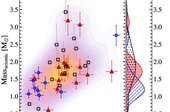 IIA BHARAT KUMAR YERRA
IIA BHARAT KUMAR YERRAAsteroseismology of Carbon-deficient Red Giants: Merger Products of Hierarchical Triple Systems?
Carbon-deficient giants (CDGs) are a rare and chemically peculiar class of stars whose origins remain under active investigation. We present an asteroseismic analysis of the entire known CDG population, selecting 129 stars observed by Kepler, K2, and TESS to obtain seismic constraints. We detect solar-like oscillations in 43 CDGs. By measuring max and applying seismic scaling relations, we determine precise masses for these stars, f inding that 79% are low mass (M ≲ 2M ⊙ ). The luminosity distribution is bimodal, and the CDGs separate into three chemically and evolutionarily distinct groups, characterized by clear trends in sodium and CNO abundances, α-element enhancement, and kinematics. We find that two of these groups are only distinguished by their initial α-element abundances, thus effectively reducing the number of groups to two. Lithium enrichment is common across all groups, linking CDGs to lithium-rich giants and suggesting a shared evolutionary origin. We find that the spectroscopic log g is systematically offset from seismic values. Group 1 CDG patterns are most consistent with formation through core He-flash mixing, while the more massive and more chemically processed Groups 2 and 2α likely formed through mergers involving helium white dwarfs, possibly in hierarchical triples. Pollution from asymptotic giant branch stars appears very unlikely, given the unchanged [C+N+O] abundance across all groups.
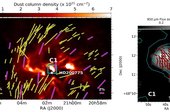 IIA MAHESWAR, G
IIA MAHESWAR, GImprints of Stellar Feedback on Magnetic Fields in the Iris Nebula NGC 7023
We present 850 μm polarized continuum observations carried out using SCUBA-2/POL-2 on the James Clerk Maxwell Telescope toward a reflection nebula, NGC 7023. The nebula is powered by the Herbig Ae Be star HD 200775 and also forms a hub in the hub-filament cloud, LDN 1172/1174. We detect submillimeter emission to the north and east of the location of the central star. The magnetic field (B-field) morphology is found to be curved and follows the clump morphology. The comparison of the B-field morphology at the clump scales (∼0.02 pc) derived using POL-2 data with that of the envelope scale (∼0.5 pc) derived using archival Planck/optical polarimetric observations suggests that the field lines are not preserved from envelope to clump scales. We suggest that this reordering of the magnetic field lines could be due to the interaction with the already evolved high-velocity outflow gas around the central star, which hints at the presence of outflow feedback. We estimated a B-field strength of 179 ± 50 μG in the starless core, and 121 ± 34 μG and 150 ± 42 μG in the protostellar cores, using the N2H+ (1–0) line observed with the 13.7 m single-dish telescope at the Taeduk Radio Astronomy Observatory (TRAO). The stability analysis gives magnetically subcritical values, while the magnetic, gravitational, and outflow kinetic energies are roughly balanced. Our study unveils the first possible evidence for magnetic field lines being shaped by outflow feedback in the vicinity of a photodissociation region driven by an intermediate-mass, pre-main-sequence star.
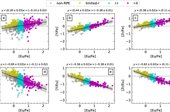 IIA PALLAVI SARAF
IIA PALLAVI SARAFOn the Origin of Neutron-capture Elements in r-I and r-II Stars: A Differential-abundance Analysis
We present a strictly line-by-line differential analysis of a moderately r-process-enhanced star (r-I: HD 107752) with respect to a strongly r-process-enhanced star (r-II: CS 31082-0001) to investigate the possible common origin of their heavy-element nucleosynthesis with high-precision abundances. This study employs European Southern Observatory data archive high-resolution and high-signal-to-noise spectra taken with the Ultraviolet and Visual Echelle Spectrograph Very Large Telescope spectrograph. Considering only the lines in common in both spectra, we estimate differential abundances of 16 light/Fe-peak elements and 15 neutron-capture elements. Abundances of O, Al, Pr, Gd, Dy, Ho, Er, and a detection of Tm in HD 107752, are presented for the first time. We found three distinct features in the differential-abundance pattern. Nearly equal abundances of light elements up to Zn are present in both stars, indicating a common origin for these elements; in addition to no noticable odd– even differential pattern. Regarding the neutron-capture elements, the r-I star exhibits mildly depleted light r-process elements and more depleted heavier r-process elements relative to r-II star. We also show that, among the r-I and r-II stars, the ratio of lighter-to-heavier r-process elements (e.g., [(Sr, Y, Zr)/Eu]) exhibits a decreasing trend with respect to the overall r-process enhancement, forming a continuous sequence from the r-I to the r-II stars. Finally, we discuss the necessity of multiple sites for the formation of r-I stars.
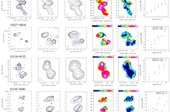 IIA RAVI JOSHI
IIA RAVI JOSHIEvidence for In-Situ Acceleration of Relativistic Particles in the Wings of X-shaped Radio Galaxies
We report evidence for in-situ acceleration/reacceleration of relativistic particles in 11 radio wings out of a total of 68 wings sufficiently well-resolved for spectral mapping, which belong to our sample of 40 X-shaped radio galaxies (XRGs). This representative XRG sample includes 15 XRGs newly reported here, which we selected from the LOTSS-DR2 survey, following well-defined criteria. The evidence for in-situ particle acceleration comes from the observed cessation of steepening, or even flattening (i.e., gradient reversal) of the spectral index profile along the lobe into the associated wing, as determined here by combining the LoTSS-DR2 (144 MHz) and FIRST (1.4 GHz) maps. Interestingly, the aforementioned trends in spectral gradient, indicative of in-situ particle acceleration, are mostly found to set in near the region where the lobe plasma stream bends to connect to the wing. Such a spatial coincidence with the bending of the radio lobe/tail has been noticed in recent years for just a couple of radio galaxies. The large increase in such examples, as reported here, is expected to give a fillip to observational, theoretical, and numerical simulation follow-up investigations of this important clue about the occurrence of in-situ particle acceleration in lobes of radio galaxies.
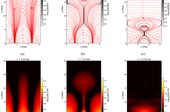 IIA SUSHREE S. NAYAK
IIA SUSHREE S. NAYAKRole of magnetic shear distribution in the formation of eruptive flux ropes
Erupting flux ropes play a crucial role in powering a wide range of solar transients, including flares, jets, and coronal mass ejections. These events are driven by the release of stored magnetic energy, facilitated by the shear in complex magnetic topologies. However, the mechanisms governing the formation and eruption of flux ropes, particularly the role of magnetic shear distribution in coronal arcades, are not fully understood. Aims. We investigate how the spatial distribution of magnetic shear along coronal arcades influences the formation and evolution of eruptive flux ropes, with a focus on the evolution of mean shear during different phases of the eruption process.Methods. We employed 2.5D resistive magnetohydrodynamic (MHD) simulations incorporating nonadiabatic effects of optically thin radiative losses, magnetic field-aligned thermal conduction, and spatially varying background heating in order to realistically model the coronal environment. A stratified solar atmosphere under gravity was initialized with a non-force-free field comprising sheared arcades. We studied two different cases by varying the initial shear to analyze their resulting dynamics and the possibility of flux rope formation and eruptions. Results. Our results show that strong initial magnetic shear leads to spontaneous flux rope formation and eruption via magnetic reconnection, driven by the Lorentz force. The persistence and distribution of shear along the arcades are crucial in determining the formation and onset of flux rope instabilities. The shear distribution infers the non-potentiality distributed along arcades and demonstrates its relevance in identifying sites prone to eruptive activity. We have explored the evolution of mean shear and the relative strength between guide field and reconnection field during the pre- and post-eruption phases, with implications of bulk heating for the “hot onset” phenomena in flares, and particle acceleration. In contrast, the weaker shear case does not lead to the formation of any flux ropes. Conclusions. The spatial distribution of magnetic shear and its evolution and mean shear play a decisive role in the dynamics of flux rope formation and eruption. Our findings highlight the limitations of relying solely on footpoint shear and underscore the need for coronal-scale diagnostics. These results are relevant for understanding eruptive onset conditions and can promote a better interpretation of coronal observations from current and future missions.
 IIA SAILI KESHRI
IIA SAILI KESHRIKinematics of the lens host S0 galaxy NGC 1553: Role of secular processes
We investigated the central structure of the S0 galaxy NGC 1553, to understand its origin and the underlying dynamical processes that shape it. The high-resolution integral field spectroscopic data from the Multi Unit Spectroscopic Explorer (MUSE) reveal a well-ordered rotation pattern, consisting of a (i) rapidly rotating nuclear disc that is somewhat decoupled from the main disc, and (ii) an inner lens; we collectively refer to these structures as the 'disc-lens'. The central peak in the velocity dispersion indicates the presence of a classical bulge. The nuclear disc is dynamically colder than the surrounding disc, while the lens is dynamically hotter. The higher-order Gauss─Hermite moments, h3 and h4, further characterise the stellar kinematics. An anti-correlation between the line-of-sight velocity and skewness (h3) is consistent with regular rotation. In contrast, the ring-like increase in kurtosis (h4) confirms the presence of the nuclear disc component. Unsharp masking of HST images has previously revealed a nuclear bar and faint spiral structures within the central ∼10 arcsec, supporting the role of secular evolution. The mass-weighted stellar age map reveals an old stellar population in the central regions, with a high metallicity that suggests the in situ formation of the disc─lens from disc material. We discuss possible formation scenarios for the disc─lens, including both minor mergers and secular processes, and examine the influence of the Dorado group environment on NGC 1553. Our findings suggest that the disc─lens in NGC 1553 formed during the early stages of the galaxy's evolution. However, its subsequent development has been shaped by internal and external processes. These results provide new insights into the origin and evolution of kinematically distinct substructures in S0 galaxies.
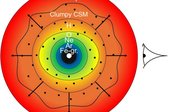 IIA ARKAPRABHA SARANGI
IIA ARKAPRABHA SARANGIJWST observations of sn 2023ixf. II. The panchromatic evolution between 250 and 720 days after the explosion
We present the nebular phase spectroscopic and photometric observations of the nearby hydrogen-rich core-collapse supernova (CCSN) SN 2023ixf, obtained through our JWST programs. These observations, combined with ground-based optical and near-infrared spectra, cover +252.67–719.96 days, creating a comprehensive, panchromatic time-series data set spanning 0.32–30 μm. In this second paper of the series, we focus on identifying key spectral emission features and tracking their evolution through the nebular phase. The JWST data reveal hydrogen emission from the Balmer to Humphreys series, as well as prominent forbidden lines from Ne, Ar, Fe, Co, and Ni. NIRSpec observations display strong emission from the first-overtone and fundamental bands of carbon monoxide, which weaken with time as the ejecta cools and dust emission dominates. The spectral energy distribution shows a clear infrared excess emerging by +252.67 days peaking around 10.0 μm, with a secondary bump at 18.0 μm developing by +719.96 days. We suggest that this evolution could arise from multiple warm dust components. In upcoming papers in this series, we will present detailed modeling of the molecular and dust properties. Overall, this work provides the community with a unique data set that can be used to advance our understanding of the mid-infrared properties of CCSNe, offering an unprecedented resource for studying their late-time line, molecular, and dust emission.
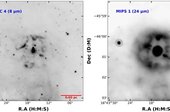 IIA ARUN, R
IIA ARUN, RDiscovery of fullerenes in the shell of candidate luminous blue variable WRAY 16-232
We report the discovery of fullerene in the circumstellar environment of WRAY 16-232, a strong candidate luminous blue variable. Multiple pointings of archival Spitzer Infrared Spectrograph spectra reveal, for the first time, the presence of prominent vibrational bands of C60 at 17.4 and 18.9 μm in a luminous blue variable (LBV) envelope, along with the strong polycyclic aromatic hydrocarbon features. These observations suggest that, despite the harsh radiative conditions, large carbonaceous molecules can form, process, and survive in the ejecta of massive stars. Complementary optical spectroscopy with South African Large Telescope High-Resolution Spectrograph shows multiple P Cygni profiles in H α, He I, and Fe II lines, which are indicative of a dense, expanding wind and substantial mass-loss. Furthermore, analysis of decade long photometric data shows short-term brightness variations of ∼0.5 mag. These results not only reinforce the classification of WRAY 16-232 as a strong LBV candidate but also provide new insights into the mechanisms of dust formation and the chemical enrichment of the interstellar medium by massive stars. We discuss various scenarios for fullerene formation in such environments, and find that shock processing due to wind-wind interactions could be playing a vital role. The shell of WRAY 16-232 has an ideal UV field strength and the time-scales appear to match with shock processing time-scales. The results highlight the need for further high spatial/spectral resolution and temporal observations to confirm the formation and survival scenario of C60 in its shell.
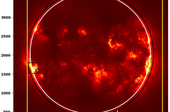 IIA RAMESH, R
IIA RAMESH, RSpectroscopic Observations of Temporal Changes in the 5303 Å Solar Coronal Emission Line During a Flare
We report long duration observations of changes in the 5303 Å (Fe XIV) solar coronal emission line parameters at heliocentric distance r≈1.07R⊙, using data obtained with the Visible Line Emission Coronagraph (VELC) onboard Aditya-L1 in the sit and stare mode. The observed changes are due to a flare near the east limb of the Sun. The intensity and width of the line are enhanced during the event. There is no change in the Doppler velocity. Our analysis indicates that the increase in line width is most likely due to an increase in temperature due to flare heating